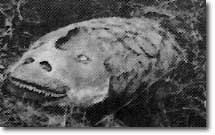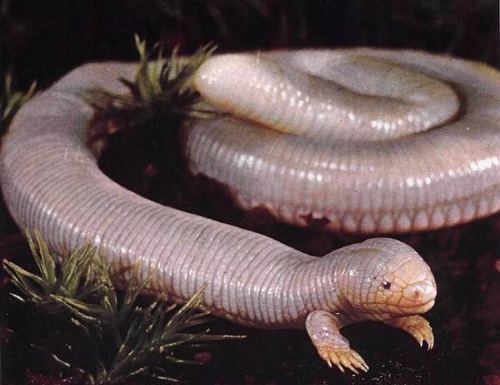Tatzelwurm – Part Ia
Posted by: Loren Coleman on July 5th, 2007

During the next few days, I will be passing along the complete contributions of Austrian cryptozoologist Luis Schönherr on the cryptid Tatzelwurm. The beginnings of this, through incomplete portions first published in Pursuit, will now be fully shared by the author with the cryptozoology community. My sincere thanks to the efforts of French cryptozoologist Michel Raynal, for bringing this material to light. Please refer to sources and references in the final installment, as well as full credit to Luis Schönherr’s son, Martin Schönherr.
Tatzelwurm – Part Ia
THE PHENOMENAL CHARACTERISTICS
The ‘Standard Tatzelwurm’
The inconsistencies in the descriptions of what is called ‘Tatzelwurm’ could suggest that this name and its synonyms are generic terms for several different, unknown and/or misperceived known animals. There have been attempts to reduce the differing descriptions to a so-called ‘standard Tatzelwurm’ 19). Specifically with Dalla Torre (Dal) and Steinböck (Ste) however, one cannot help getting the impression that the self-imposed obligation to distill one single animal from the differing descriptions leads to the rejection of reasonable reports and, if the basic outlook is an unrestrained scepticism 20), finally must result in the dismissal of the whole subject. Therefore I have contended myself with presenting the reports as they are, using them as tie ups in pointing out correlations, references and ideas.
A p p e a r a n c e
While snake, lizard, salamander or cat seem to be reasonable comparisons, size or appearance of the animal’s head or even its whole body has also been compared with a baby, as has been noted by several authors (Alp/377, Sin1/266, Tra2/132, Dal/219/221, Mag/19). This is a strange comparison, for what could be farther from any known animal of the Alps than a baby? In the Tyrol the Tatzelwurm has been likened to a ‘Fatschenkind’ (1857.b. Wurmbachtal) 8) or it was described as pear- or wedge-shaped (1921.07.), (1927-8.), or simply as very thick compared with its length. This hardly fits a snake, not even one crammed with food and who would in this condition have difficulties to crawl, let alone jump or pursue men. Other, perhaps related comparisons are, ‘like a multiply bonded sausage’ (1934.b. W”rgl?), or simply ‘like a sausage’ (1927.b. Mongolia) or like ‘a crayfish or a sausage’ (1929.08. Palu). All this seems to point to a structured body composed of ring-like segments and could indicate that the animal was perhaps no vertebrate but something of the articulates as the term ‘worm’ taken literally could imply.

T h e E y e s
Reports describing the eyes of the animal in terms like ‘prominent’, ‘sharp’, ‘gleaming’, ‘big’, or ‘hypnotic’, ‘devilish’ and ‘murderous’ 21) argue strongly against the idea that known snakes or lizards etc. were observed. The eyes of the reptiles indigenous to the Alps, even if viewed at the relatively close distance of two to three meters, are really not an exciting affair.
L e n g t h a n d T h i c k n e s s
It is one of the standard objections by sceptics that fear leads to gross overestimations of size 22). By overemphasizing this argument it is easy to discard cases that otherwise had to be considered strange by the mere size of the reported animal. The influence of fear on size estimates, however, seems far from being proven. In a modern book on perceptual psychology I couldn’t find a reference to this factor 23).

H o w M a n y P a w s ?
The Bipes
With respect to mere appearance the genus Bipes seems to be a comfortable explanation when Tatzelwurms with two fore legs only are reported. According to Smith and Taylor 24) the Bipes belongs to the family Bipedidae, suborder Amphisbaenia 25), the term ‘amphisbaenia’ literally meaning ‘to go on both ends’ i.e. an animal whose head and tail are hard to distinguish. A drawing of the Bipes Chirotes canaliculatus Bonnaterre (Bre1/150) shows a worm-like animal with only one pair of little paws immediately behind the head. The maximal length is given with 20 cms. At the turn of the century it was known to be indigenous to Mexico, California and the PlatteÊriver region (Bre1/149), the 1976 edition of the same book (Bre2/226) mentiones only Mexico as their habitat. Their way of life is preferably burrowing. The assumption of the existence in the Alps of a larger variety of, say, the Bipes Chirotes canaliculatus poses difficulties. There are cases that would not match regarding other characteristics: it cannot move fast, it doesn’t jump, it is not aggressive and according to Ste/467 it is impossible that it could live in rocky ground or in alpine soil not so rich in food as tropical earth.
The Skink
In at least one case (1833.b.) the witness described a possibly snake-like animal with four short, scarcely noticeable feet. This could be suggestive of a skink (Scincidae), a family of the sauria, having sometimes very degenerated feet. Skinks are not considered indigenous to the Alps.
The Peripatus
Studer (1814) and Wyss (1817) spoke already of Stollenwurms with more than two pairs of legs without however quoting specific cases. Of the respective observations in my catalogue the last one (1927-8. Löberhof) is the best documented. It seems to argue against a vertebrate and among the invertebrates the species Peripatus of the phylum Onychophora comes nearest to what has been described. When smelling the Peripatus raises the front part of its body. Its movements are rather unhurried, therefore the name (Peripatus = stroller). What does not match however, is the size. Reported lengths in the catalogue are 40 and 60 cms, the largest species of the Onychophora, the Peripatus torquatus Kennel, measures maximal 15 centimeters. It also has no pronounced neck, i.e. the head doesn’t contrast against the body. The Peripatus is mainly indigenous to the equator region. Only in the Himalaya it is found up to 28 degrees northern latitude. A Peripatus in South Tyrol (at 47 degrees) measuring 40 cms would be a minor sensation.
About Loren Coleman
Loren Coleman is one of the world’s leading cryptozoologists, some say “the” leading living cryptozoologist. Certainly, he is acknowledged as the current living American researcher and writer who has most popularized cryptozoology in the late 20th and early 21st centuries.
Starting his fieldwork and investigations in 1960, after traveling and trekking extensively in pursuit of cryptozoological mysteries, Coleman began writing to share his experiences in 1969. An honorary member of Ivan T. Sanderson’s Society for the Investigation of the Unexplained in the 1970s, Coleman has been bestowed with similar honorary memberships of the North Idaho College Cryptozoology Club in 1983, and in subsequent years, that of the British Columbia Scientific Cryptozoology Club, CryptoSafari International, and other international organizations. He was also a Life Member and Benefactor of the International Society of Cryptozoology (now-defunct).
Loren Coleman’s daily blog, as a member of the Cryptomundo Team, served as an ongoing avenue of communication for the ever-growing body of cryptozoo news from 2005 through 2013. He returned as an infrequent contributor beginning Halloween week of 2015.
Coleman is the founder in 2003, and current director of the International Cryptozoology Museum in Portland, Maine.










Hey Loren! thanks for those infos. The problem with the Tatzelwurm is that there are no modern sightings. If it ever existed it’s probably extinct now. By the way: Heuvelmans also studied the tatzelwurm.
Funny how that Gaff at the top bears a striking similarity to the occasional reappearing old B/W picture of the giant fake fish (with the men standing around it) that no one seems to be able to identify.
If you viewed this Gaff from the side it would probably be quite a match.
tatzelwurms always were my favorite folklore creatures. thanks for posting this, Loren!
Fascinating, Loren, thanks for passing this along. On a quick search to refresh myself, I found also mention of the legend of the Lindworm. Do you think there might be a correlation?
I love the Tatzelwurm stuff!!!
Always one of those really weird things that you never had enough info on to even make an educated guess…I know what the skeptics are saying, but all interesting…appreciate the info!!!